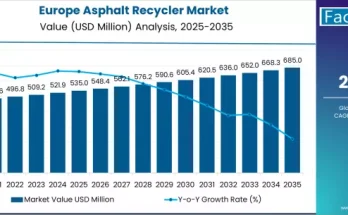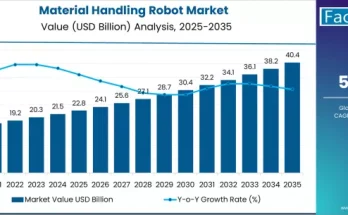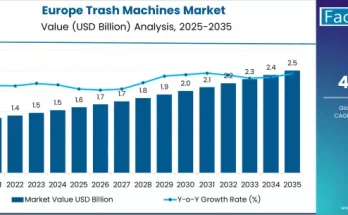The helical gear market is witnessing steady expansion as industries increasingly seek high-efficiency mechanical systems for power transmission and motion control. Helical gears, known for their quiet operation, durability, and load-bearing capacity, are essential components across industries ranging from automotive and aerospace to energy, robotics, and manufacturing.
As industrial automation and high-performance engineering continue to evolve, helical gears are being optimized for improved torque transmission, reduced vibration, and extended service life. The market’s growth reflects the ongoing demand for precision-engineered components that enhance machine performance, operational reliability, and energy efficiency.
Market Overview
Helical gears are cylindrical gears with angled teeth that engage gradually, providing smoother and quieter operation compared to spur gears. Their ability to handle high-speed applications and heavy loads makes them indispensable in machinery where precision and efficiency are paramount.
The growing adoption of automated manufacturing systems, electric vehicles, and industrial robots has accelerated the demand for high-precision gearing solutions. Modern helical gears are manufactured using advanced materials and computer-aided design technologies that ensure optimal strength, wear resistance, and accuracy.
Manufacturers are increasingly focusing on innovations in surface treatment, lubrication systems, and heat-resistant alloys to meet the rising performance requirements of modern mechanical systems. The integration of digital monitoring and predictive maintenance tools into gear manufacturing and operation processes is also reshaping the industry, enhancing reliability and reducing downtime.
Furthermore, the shift toward energy-efficient systems and environmentally sustainable industrial operations is driving the adoption of lightweight and low-friction helical gear designs, which reduce mechanical losses and extend the lifespan of machinery.
Regional Insights
North America
North America remains a prominent market for helical gears, driven by advanced manufacturing capabilities, widespread industrial automation, and a strong automotive base. Continuous investments in renewable energy projects, robotics, and aerospace engineering are supporting the adoption of precision gear solutions. Additionally, the presence of leading gear manufacturers and high demand for customized gear assemblies reinforce the region’s market dominance.
Europe
Europe’s strong engineering heritage and emphasis on innovation and sustainability are fueling market growth. The region’s automotive and industrial machinery sectors are key consumers of helical gears, focusing on improved efficiency, noise reduction, and reduced maintenance needs. Moreover, stringent energy efficiency standards and increased electrification across industries are prompting manufacturers to adopt advanced helical gear technologies.
Asia-Pacific
Asia-Pacific is emerging as a high-growth region due to rapid industrialization, manufacturing expansion, and increasing investments in heavy machinery and transportation infrastructure. Countries such as China, Japan, and India are witnessing growing demand for automation and precision engineering solutions. The rising production of electric vehicles and industrial robots is also contributing significantly to regional market development.
Rest of the World
The Middle East, Africa, and Latin America are gradually embracing automation and industrial modernization. Expanding oil & gas, mining, and energy industries in these regions are generating steady demand for reliable mechanical transmission systems, including helical gears, that can withstand heavy-duty operations and harsh environmental conditions.
Key Trends & Forecast
- Advancements in Gear Material and Design
The introduction of advanced materials, such as high-strength alloys and composite coatings, is enhancing the performance and longevity of helical gears. Modern design techniques, including computer-aided engineering and 3D modeling, are enabling the production of lightweight yet durable components. - Integration of Smart Manufacturing Technologies
Industry 4.0 is reshaping the helical gear manufacturing process. Digital twins, IoT-enabled sensors, and AI-driven predictive maintenance systems are helping manufacturers improve production precision, minimize defects, and extend product life cycles. - Rising Adoption in Electric and Hybrid Vehicles
The transition toward electric mobility is driving innovation in gear design. Helical gears are being optimized to handle the unique torque and speed characteristics of electric drivetrains while ensuring silent operation and high efficiency. - Focus on Energy Efficiency and Sustainability
Manufacturers are developing eco-friendly gears with lower friction coefficients, which contribute to reduced energy consumption and carbon emissions in industrial systems. Sustainable production methods and recyclable materials are also gaining traction. - Customization and Modular Gear Solutions
End users increasingly demand tailored gear assemblies that meet specific application requirements. Modular helical gear designs allow for flexibility, easier installation, and cost-effective maintenance across diverse industrial setups.
Applications & End-Use Outlook
Helical gears serve as vital components across a broad range of industries that rely on efficient power transmission and mechanical precision. Their versatility and robust performance make them suitable for both high-speed and high-torque applications.
- Automotive Industry: Widely used in transmissions, differentials, and steering systems, offering quiet operation and enhanced load distribution.
- Aerospace: Employed in aircraft engines, landing gear mechanisms, and flight control systems for precision and reliability.
- Industrial Machinery: Integral to conveyors, compressors, pumps, and robotics systems, ensuring smooth and stable performance.
- Energy Sector: Utilized in wind turbines, hydraulic systems, and power plants, where efficiency and durability are crucial.
- Construction and Mining: Used in heavy-duty machinery and equipment to handle high torque loads and continuous operation under harsh conditions.
- Marine and Railways: Provide consistent motion control and reduce vibration in propulsion systems and heavy transport equipment.
As industries modernize, automation, robotics, and digital maintenance tools are increasingly integrated with helical gear systems to improve operational intelligence and efficiency.
Challenges and Opportunities
Despite its promising growth, the helical gear market faces challenges such as fluctuating raw material prices, manufacturing complexities, and the need for high-precision machining. Additionally, maintaining noise and vibration control at high operational speeds remains a technical hurdle for gear designers.
However, these challenges are paving the way for innovation. Advances in additive manufacturing (3D printing) and CNC machining are enabling the production of complex, high-precision gear geometries at lower costs. The growing use of simulation software and AI-based quality assurance tools is further helping manufacturers optimize production and minimize wastage.
Opportunities also lie in emerging sectors such as renewable energy, electric mobility, and industrial automation — where high-performance, compact, and efficient gear systems are essential. Manufacturers investing in R&D for lightweight materials and sustainable production processes are well-positioned to capitalize on this evolving landscape.
Conclusion
The helical gear market stands at the forefront of industrial innovation, driving advancements in machinery efficiency, precision engineering, and automation. As industries shift toward cleaner energy, smarter production, and enhanced mechanical performance, helical gears will remain indispensable to global manufacturing and power transmission systems.
Their unique combination of strength, smooth operation, and adaptability continues to make them a cornerstone of modern engineering. Looking ahead, the future of the helical gear market will be defined by technological integration, sustainable materials, and digital transformation, ensuring that gears not only power machines — but also the evolution of industry itself.
Browse Full Report – https://www.factmr.com/report/2203/helical-gear-market



